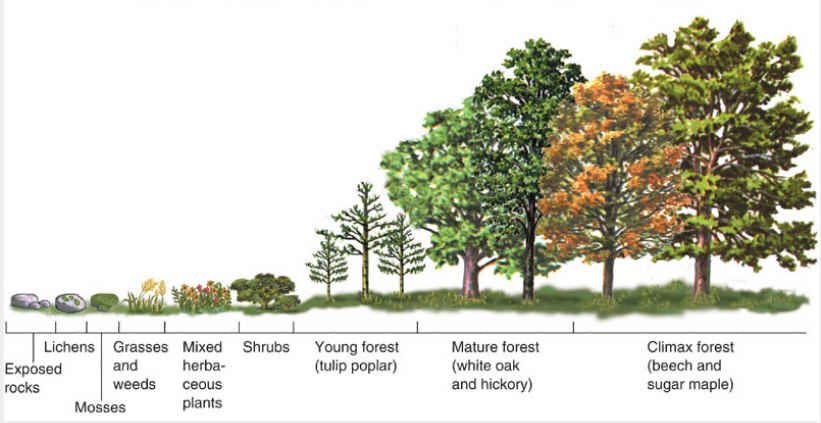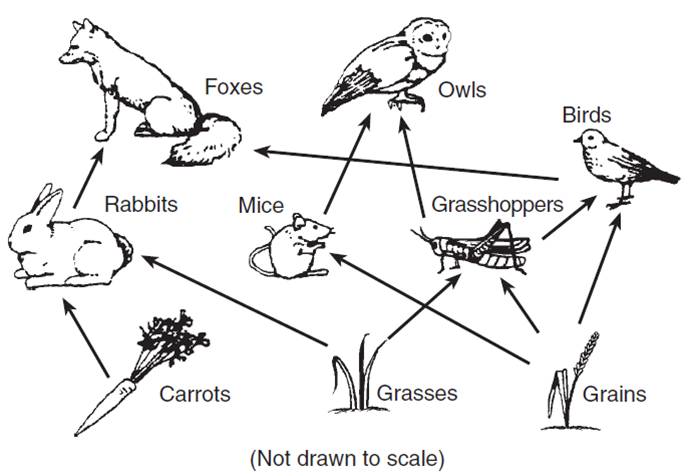The term ‘ecosystem’ was first used by A. G. Tansley in 1935. Tansley defined an ecosystem as a particular category of physical systems, consisting of organisms and inorganic components in a relatively stable equilibrium, open, and of various sizes and kinds.
- An ecosystem is a structural and functional unit of nature where there are interactions between living organisms and non-living components that determine the flow of energy and nutrients.
- e.g. pond ecosystem, forest ecosystem, grasslands, deserts, etc.
Ecosystem stability/balance
Stability is commonly defined as a state in which change does not occur.
In ecology, ecosystem stability is defined as the ability of an ecosystem to maintain its structure (e.g. landscape, species diversity, etc.) and function (e.g. nutrient and water cycling, biomass production, etc.) over a long period of time despite disturbances.
Fully developed or mature ecosystems are more stable than immature ecosystems.
- Mature ecosystems are considered stable because their structure and function remain more or less the same over a long period of time.
- Stable ecosystems are in a state of dynamic equilibrium in which things change but remain more or less the same.
- Stability is the ability of a disturbed ecosystem to return to its original condition (resilience).
- Stability is also a property of an ecosystem that causes it to resist being changed by natural events or by human interferences (resistance).
Ecosystem homeostasis/balance
- Stability is also known as homeostasis.
- Homeostasis is the dynamic equilibrium among the living members of an ecosystem, against environmental conditions such as wind, rainfall, nutrient availability, air quality, and climate.
Immature vs Mature ecosystems
| Immature Ecosystem | Mature Ecosystem |
| Plants are small in size. | Plants are large in size. |
| Species diversity is low. | Species diversity is high. |
| Communities are mostly producers and few decomposers. | The mixture of producers, consumers, and decomposers. |
| Few ecological niches (generalized). | Many ecological niches (specialized). |
| Low community organization. | High community organization. |
| The efficiency of nutrient cycling is low. | The efficiency of nutrient cycling is high. |

Factors that influence ecosystem balance/stability
The following are the factors that influence the ecosystem
stability:

A. Population growth and reduction factors
B. Species diversity
C. Food web complexity
D. Movement of nutrients and energy
E. Succession
A. Population growth and reduction factors
- The factors that affect an ecosystem’s stability are the factors that control the size of its populations.
- These factors are of two types:
- Growth factors: Factors that tend to increase population size.
- Reduction factors: Factors that tend to decrease population size.
B. Species diversity and ecosystem stability
- Ecosystem stability may also be affected by species diversity.
- Species diversity is related to at least three variables: The number of different species in an ecosystem, the number of individuals in each species, and the number of individuals of all species in a community.
- Species diversity is high in mature or climax communities.
- The mature ecosystem will remain at this stage until natural disasters or human intervention occurs.
- A high-level diversity is believed to confer a high degree of stability.
C. Food web complexity in ecosystem stability
- An ecosystem with a more complex food web is more stable than an ecosystem with a simple food web.
- In a complex food web, one organism has an alternative source of food and energy while the number of energy sources of an organism is less in a simple food web.


D. Movement of nutrients and energy
- The movement of nutrients and energy influences the stability of an ecosystem. It occurs through the food chain. The continuity of the food chain maintains ecosystem balance while any disruption in the food chain interrupts ecosystem balance.
E. Succession influences ecosystem stability
- Succession is the replacement of one community by another community in a particular area over time.
- Succession gradually leads to a more complex community over a period of time.
- A climax community is more diverse than a community of early stage during succession.
Imbalance in ecosystem
- Stability is a useful concept to apply to the ecosystem. It helps in understanding imbalances that occur naturally or from human activities.
- Small scale change
- An ecosystem balance can be tilted temporarily by natural shifts in the abiotic and biotic growth and reduction factors. Small shifts in these factors in an ecosystem are fairly common. The ecosystem responds to these changes in a way that ensure the survival of the community.
- However, drastic shifts can seriously, sometimes irreversibly cause an imbalance in the ecosystem.
- Large-scale change:
- Major ecosystem perturbation may be caused by natural events (shifts in climate, floods, volcanic eruption, fires, and drought, or human intervention such as mining and logging.
- In either case, damage to the ecosystem may be so severe that it takes years or decades for the original condition to be restored.
Human impact on ecosystems
1. Altering biotic factors

a) Introducing competitors
From time to time, humans have introduced foreign species into new regions only to tackle serious problems caused by the excessive growth of the introduced species.
12 pairs of European rabbits were introduced to Australia in 1839. Eat grasses for sheep. The number of rabbits in 1933 became 1 billion.
Water hyacinth was introduced in 1884 in Florida. 10 plants multiplied into 60,000 in 8 months. They clogged waterways and cost 11 million USD to clear it.
b) Eliminating or introducing predators
Humans have a tendency to eliminate predators such as bears, eagles, and wolves from their habitat. Occasionally predators are introduced into the area (mosquito fish).
In 1900, wolves, coyotes, and mountain lions were eliminated from the Kaibab Plateau, North of the Grand Canyon. The number of deer increased from 4000 to 100,000. eat grasses and vegetation. The next year died.
c) Introducing disease organisms:
Humans have unknowingly introduced pathogens into new environments where there were no controls. They reproduce at a high rate and cause serious damage.
2. Altering abiotic factors
a) Creating pollution: Water pollution and air pollution caused by humans create an unfavorable environment for many organisms. Oil spillage, toxic pesticides, thermal pollution, etc.
b) Depleting resources: Human pollution may deplete or destroy resources used by other species.
Ecosystem resistance and resilience
| Resistance | Resilience |
| Property of communities to remain ‘essentially unchanged’ when subject to disturbance. | Ability to return to a former successional trajectory after being degraded or deflected by outside disturbances. |
| Show little impact due to repeated disturbances over time. | Immediately impacted by even low-intensity disturbances. |
| Disturbance without loss. | Capacity to recover from a disturbance after incurring losses. |
| No internal re-organization and succession change are needed. | The system is internally re-organizing, perhaps through a mosaic of patches that are at different stages of reassembly. |
| Loss of resistance can’t display an early warning signal of a collapse. | Loss of resilience can display an early warning signal of a collapse. |
 Plantlet The Blogging Platform of Department of Botany, University of Dhaka
Plantlet The Blogging Platform of Department of Botany, University of Dhaka






Your post is not just informative but also incredibly thought-provoking. Thanks for sharing your insights.
Your post is a treasure trove of information. It’s evident you’ve put a lot of research into it.